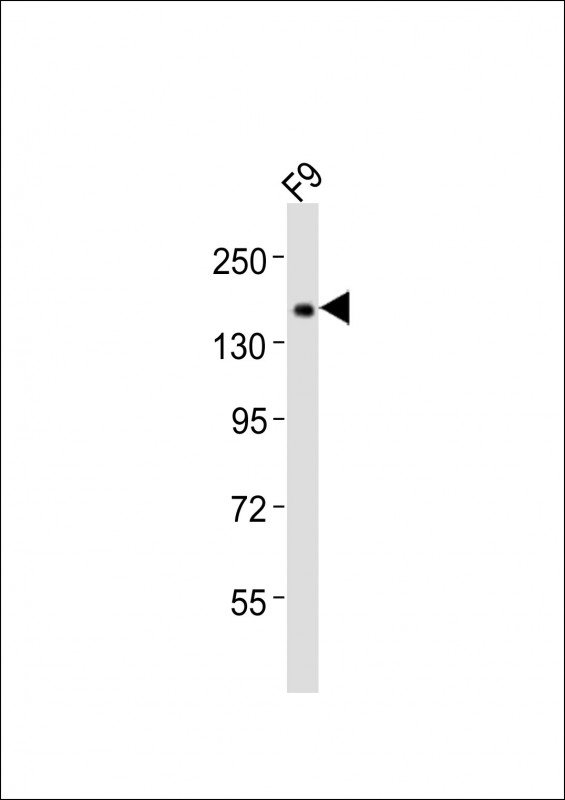
| WB | 1/2000 | Human,Mouse,Rat |
| IF | 咨询技术 | Human,Mouse,Rat |
| IHC | 咨询技术 | Human,Mouse,Rat |
| ICC | 技术咨询 | Human,Mouse,Rat |
| FCM | 咨询技术 | Human,Mouse,Rat |
| Elisa | 咨询技术 | Human,Mouse,Rat |
| WB Predicted band size | 219.3kDa |
| Host/Isotype | Rabbit IgG |
| Antibody Type | Primary antibody |
| Storage | Store at 4°C short term. Aliquot and store at -20°C long term. Avoid freeze/thaw cycles. |
| Species Reactivity | Mouse |
| Immunogen | This mouse Tet1 antibody is generated from a rabbit immunized with a KLH conjugated synthetic peptide between 1845-1879 amino acids from the C-terminal region of mouse Tet1. |
+ +
以下是关于小鼠Tet1抗体的3篇参考文献及其摘要概括:
---
1. **文献名称**: "Tet1 loss leads to increased DNA methylation at promoters and enhanced gene expression during mouse embryogenesis"
**作者**: Dawlaty, M. M., et al. (2011)
**摘要**: 该研究通过Western blot和免疫组化实验,利用小鼠Tet1特异性抗体,揭示了Tet1缺失导致胚胎干细胞中特定基因启动子区DNA甲基化增加,并影响胚胎发育相关基因的表达模式。
---
2. **文献名称**: "Tet1 controls meiosis by regulating meiotic gene expression"
**作者**: Yamaguchi, S., et al. (2012)
**摘要**: 作者通过免疫沉淀(IP)和免疫荧光技术,使用小鼠Tet1抗体证明Tet1在生殖细胞减数分裂中的作用,发现其通过调控关键基因的5-羟甲基化水平影响减数分裂进程。
---
3. **文献名称**: "Dynamic regulation of 5-hydroxymethylcytosine in mouse ES cells during neural differentiation"
**作者**: An, J., et al. (2015)
**摘要**: 该研究利用Tet1抗体进行ChIP-seq和Western blot分析,发现小鼠胚胎干细胞向神经分化过程中,Tet1通过介导DNA去甲基化参与神经相关基因的转录激活。
---
4. **文献名称**: "Critical role of Tet1 in shaping the epigenome of embryonic stem cells"
**作者**: Koh, K. P., et al. (2011)
**摘要**: 研究通过Tet1抗体进行染色质免疫共沉淀(ChIP)和功能缺失实验,阐明Tet1通过维持胚胎干细胞关键多能性基因的低甲基化状态,调控其自我更新和分化潜能。
---
这些文献均明确使用了针对小鼠Tet1的抗体,并涵盖了其在胚胎发育、生殖细胞减数分裂及神经分化中的功能研究。
The TET1 (Ten-Eleven Translocation 1) antibody is a key tool for studying the role of the TET1 enzyme, a member of the TET family of dioxygenases that catalyzes the oxidation of 5-methylcytosine (5mC) to 5-hydroxymethylcytosine (5hmC) in DNA. This process is critical for active DNA demethylation and epigenetic regulation, influencing gene expression, embryonic development, and cellular differentiation. Mouse TET1 antibodies are specifically designed to recognize and bind to the TET1 protein in murine models, enabling researchers to investigate its expression, localization, and function in various biological contexts, such as stem cell pluripotency, cancer biology, and neurological disorders.
These antibodies are typically generated by immunizing host animals (e.g., rabbits or mice) with purified TET1 protein fragments or synthetic peptides corresponding to conserved regions of the murine TET1 sequence. They are validated for applications like Western blotting, immunoprecipitation, immunofluorescence, and chromatin immunoprecipitation (ChIP). Specificity is confirmed using knockout controls or siRNA-mediated TET1 depletion. High-quality TET1 antibodies exhibit minimal cross-reactivity with other TET family members (e.g., TET2. TET3) and are essential for elucidating TET1's role in modulating DNA methylation dynamics, particularly in studies involving embryonic stem cells, germline development, or diseases linked to epigenetic dysregulation, such as leukemia or neurodevelopmental disorders. Proper validation ensures reliability in both qualitative and quantitative analyses.
×